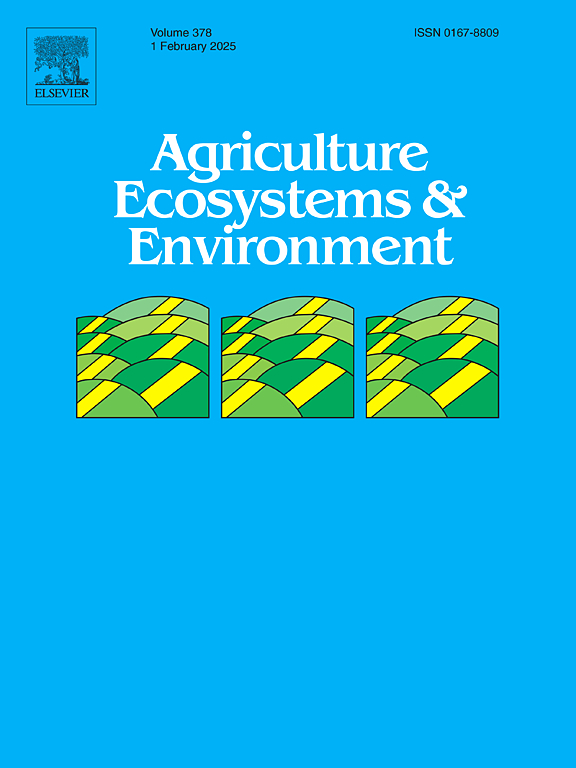氮肥减量条件下缓释肥与生物炭对作物产量和土壤碳氮动态的协同效应
IF 6
1区 农林科学
Q1 AGRICULTURE, MULTIDISCIPLINARY
引用次数: 0
摘要
在减少肥料投入的同时提高作物产量和提高农业生态系统土壤碳氮储量仍然是一个严峻的挑战。然而,氮肥减量后,添加各种功能外源添加剂是否能提高土壤碳(C)和氮(N)储量,目前尚不清楚。本文报道了在两种氮素水平农业系统(无氮素减量:NNR和30% %氮素减量:NR30)下,小麦-玉米复合绿肥轮作系统中土壤碳氮储量对缓释肥料(SRF)和土壤改剂剂(生物炭和土棒土)组合的响应机制。我们发现,SRF和生物炭组合显著提高了两种系统的作物产量、土壤养分(铵态氮和硝态氮)、土壤微生物生物量碳(MBC)和氮(MBN),且NR30系统的增产幅度明显大于NNR系统(产量+19.5 %,养分+60 %~85 %,MBC和MBN +18 % ~ 44 %),产量+17.0 %,养分+31 % ~ 35 %)。MBC和MBN为+16 % ~ 40 %),通过诱导土壤负启动效应,确保连续供氮。SRF和生物炭的组合可以减少至少30% %的氮输入,同时仍能增加土壤C(1.98 % ~ 7.90 %)和N储量(49.83 % ~ 56.61 %),这归因于NR30系统下氮还原缓解绿肥“氮抑制”和生物炭增强土壤氮相关胞外酶活性对MBN变化的敏感性的双重调控机制。这一发现为可持续旱地农业提供了新的见解。本文章由计算机程序翻译,如有差异,请以英文原文为准。
Synergistic effects of slow-release fertilizer and biochar on crop yield and soil carbon-nitrogen dynamics under reduced nitrogen input
Reducing fertilizer input while improving crop yield and enhancing soil carbon and nitrogen storage in agricultural ecosystems remains a serious challenge. However, it remains unclear whether the addition of exogenous additives with various functions can enhance soil carbon (C) and nitrogen (N) stocks following nitrogen fertilizer reduction. Here, we report results from a wheat-maize rotation system with multiple cropping green manure designed to understand the response mechanism of soil C and N storage to slow-release fertilizer (SRF) and soil amendments (biochar and attapulgite) combination in two nitrogen level agricultural systems (no nitrogen reduction: NNR, and 30 % nitrogen reduction: NR30). We found that SRF and biochar combination significantly increased crop yield, soil nutrients (ammonium nitrogen and nitrate nitrogen), soil microbial biomass carbon (MBC) and nitrogen (MBN) in both systems, and the increase magnitude was notably greater in the NR30 system (+19.5 % for yields, +60 %~85 % for nutrients, and +18 %∼44 % for MBC and MBN) compared with the NNR system (+17.0 % for yields, +31 %∼35 % for nutrients, and +16 %∼40 % for MBC and MBN) by inducing soil negative priming effects and ensuring the continuous nitrogen supply. The combination of SRF and biochar could reduce nitrogen input by at least 30 % while still increasing soil C (1.98 %∼7.90 %) and N storage (49.83 %∼56.61 %), which attributed to the dual control mechanism that nitrogen reduction alleviated the 'nitrogen repression' of green manure and biochar enhanced the sensitivity of soil nitrogen-related extracellular enzyme activities to changes in MBN under NR30 system. This finding offers new insights for sustainable dryland agriculture.
求助全文
通过发布文献求助,成功后即可免费获取论文全文。
去求助
来源期刊

Agriculture, Ecosystems & Environment
环境科学-环境科学
CiteScore
11.70
自引率
9.10%
发文量
392
审稿时长
26 days
期刊介绍:
Agriculture, Ecosystems and Environment publishes scientific articles dealing with the interface between agroecosystems and the natural environment, specifically how agriculture influences the environment and how changes in that environment impact agroecosystems. Preference is given to papers from experimental and observational research at the field, system or landscape level, from studies that enhance our understanding of processes using data-based biophysical modelling, and papers that bridge scientific disciplines and integrate knowledge. All papers should be placed in an international or wide comparative context.
 求助内容:
求助内容: 应助结果提醒方式:
应助结果提醒方式:


